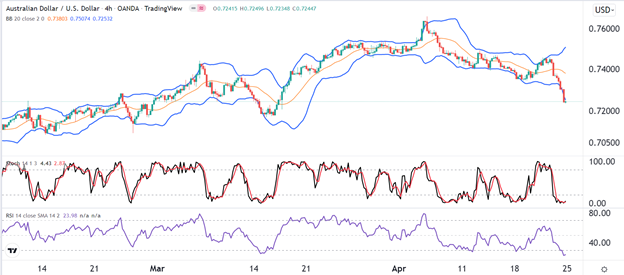Bullish View
- Buy the AUD/USD and set a take-profit at 0.7300.
- Add a stop-loss at 0.7150.
- Timeline: 1-2 days.
Bearish View
- Set a sell-stop at 0.7220 and a take-profit at 0.7150.
- Add a stop-loss at 0.7300.
The AUD/USD slipped to the lowest level since March 16th as the US dollar rally continued amid fears of a more hawkish Federal Reserve. The pair is trading at 0.7245, which is about 5.50% below the highest level this week.
Australian Dollar Pressured
The Aussie has been under intense pressure in the past few weeks for a number of reasons. First, after soaring during the start of the Russian invasion of Ukraine, commodity prices have cooled a bit recently. The Bloomberg Commodity Index has dropped by more than 5% from its highest level in April this year. This is notable since the Australian dollar is often seen as a leading commodity currency.
Second, the US dollar has been in a strong bullish trend in the past few days. The dollar index, which tracks the greenback against a basket of currencies, has jumped to the highest level since 2020. This rally accelerated last week after Jerome Powell hinted that the Fed will be more aggressive in the coming months. Now, analysts expect that the Fed will deliver a 0.50% rate hike in May and then start its quantitative tightening (QT) policy.
Third, the AUD/USD pair has retreated as investors eye the upcoming Australian election. It will pit Scott Morrison and Andrew Albanese of the labor party. While most analysts expect that Scott Morrison will win his second term, most of them believe that the election will be close. Still, it is unclear how these results will impact the Australian dollar.
This week, the Australian dollar will react to the latest inflation data scheduled for Wednesday. Analysts expect these numbers to show that inflation rose from 3.5% in Q4 to 4.6% in Q1 of this year as energy prices rise. On a QoQ basis, they expect that the CPI rose from 1.3% to 1.7%.
AUD/USD Forecast
The AUD/USD pair has been in a strong bearish trend in the past few days. On the four-hour chart, the pair’s Bollinger Bands have widened, signaling that there is intense volatility. At the same time, the Relative Strength Index (RSI) has moved to the oversold level and is still pointing downwards. The Stochastic oscillator has also moved to the oversold level.
Therefore, while the overall trend is bearish, a relief rally is expected to happen in the near term. If this happens, the next key resistance level to watch will be at 0.7300.

